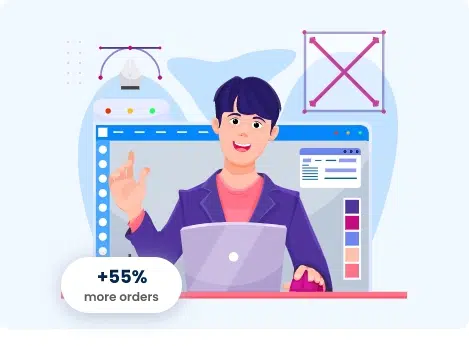In 2019, just 3% of eCommerce sites visited changed into purchases. Low conversion rates and troubles in accomplishing clients are only a glimpse of something more significant: maintaining an eCommerce business accompanies its arrangement of difficulties and issues can harm the income, make financial losses and even lead to a decrease in its worth. The online shopping industry has been developing at an inconceivable rate, thus having online business challenges. The ascent of digitalization has changed how online retailers work. Although this online methodology has made shopping simpler for buyers, it has also brought major eCommerce issues and challenges — like site streamlining and service over numerous digital touchpoints.
[elementor-template id=”40860″]
Major issues and challenges in eCommerce
Pioneers across the globe face numerous eCommerce issues while adjusting to the advanced digital business. As per a new report, it’s assessed that there will be 2.14 billion worldwide digital purchasers in 2021, while deals are anticipated to represent 18.1% of retail sales. Even though it gives immense potential to development and achievement, retailers need to manage a few online businesses to make it in the present internationally cutthroat market. Thus, if you own a small e-business yourself or a major organisation, you should pursue this cautiously! We will list the 10 major issues, and challenges eCommerce store owners face.
- Retailers worldwide are constantly attempting to assemble their standing and a sharp brand picture with the guarantee of an incredible encounter. When experience matters the most and tech goliaths like Amazon are taking the web-based purchasing cycle to the notorious ‘next level’ with expectant transportation strategies, it is truly challenging to meet client assumptions. Along these lines, contending with them and satisfying the steadily developing client requests is difficult for retailers today.
- Personalization is the key component for a decent client experience. Retailers are fixated on furnishing their clients with a customised insight notwithstanding, these experiences can become over-customized without them seeing it. Clients can get irritated by the extreme measure of designated online promotions. In this hustle, retailers pass up fostering a cooperative relationship with the clients. This transforms into a significant test for the business to guarantee that the client feels esteemed as a person. 84% of clients report that being dealt with like an individual rather than simply a number that adds to an organisation winning their business is necessary to their client experience.
- Consistency is the essential component while building an effective omnichannel system. Clients utilise different stages to look for things before settling on a choice which expects organisations to give consistent buying experiences through each item or administration they offer. Nonetheless, examining and understanding client connections across all touchpoints and utilising them to construct predictable and consistent client experience is one of the major eCommerce challenges for retailers.
- Profoundly, the all-encompassing brand arrangement is one of the critical eCommerce challenges. Regularly, eCommerce turns into an independent side business rather than an utterly coordinated piece of the business all in all. To work with this association, organisations are buckling down towards building eCommerce arrangements that are information empowered. This will assist organisations with transportation to store the board and omnichannel structures like BOPIS. Completely utilising the information from computerised trade capacities will likewise help measure Key Performance Integrals (KPIs), past transformation rates and Average Order Values (AOV). Rather than testing dependent on expected market patterns, information should be efficiently caught and applied imaginatively. Business people need to recognize the effect of data on the everyday just as long term business choices.
- The take-up of eCommerce raises worries about security dangers. This is one of the most basic challenges faced by ecommerce owners. There is an approaching danger of programmers and fraudsters assaulting the host server, taking secret information, and presenting infections. Break of credit and charge card subtleties has become normal news, and such slips straightforwardly influence a customer’s trust. Phishing is one more danger where programmers act like a business and request delicate data from their clients. A few clients are progressively worried about the eCommerce sites’ capacity to adequately protect their way of life, just as the security of the transaction details.
- Indeed, even the greatest players in the eCommerce segment battle to hold their client base. The justification behind client-driven eCommerce difficulties can be ascribed to many factors, for example, the developing assumption for the purchaser, the presence of a few comparable choices, inability to give a wonderful shopping experience, and once in a while, the offers and limits being more considerable on different stages. Client loyalty is, to be sure, a deciding angle in a business’ prosperity, and surprisingly a minor error from the retailer can demolish the brand’s notoriety for a shopper. Numerous organisations neglect to comprehend that attempting to hold a client is tied in with putting resources into building a consistent and remunerating relationship with them and utilising each channel of correspondence to appear this relationship.
- The web offers everybody an equivalent platform and consequently an equal chance. This makes the climate very cutthroat, with conceivably many different organisations providing similar items or services to a similar interest group. Indeed, even the most speciality brands need to contend energetically to cut a spot for themselves. Each fragment in the eCommerce space is set to get progressively blocked and cutthroat throughout the long term. A local startup needs to stay up with a multinational giant and the other way around. The undertaking is constantly testing to think of an inventive eCommerce business answer to gain an edge.
- For eCommerce organisations, drawing great traffic might be reachable through promotions and other marketing endeavours, yet getting the important leads stays a gigantic task. It is no big surprise that the regular eCommerce change rates are frequently negligible. Indeed, it has been accounted for that just 2.57% of eCommerce site visits have been changed over into buys in the US. The efforts invested in converting the visitor into a client can be useless if the right crowd isn’t getting to the site. Tragically, usually, brands neglect to convey the right message about their item or service and subsequently can’t connect with the targeted audience.
- Technological associations are becoming progressively well known in the eCommerce area. When organisations hold hands with an organisation to rejuvenate their thought, there is a lot at stake. The final result can be a success by zeroing in on the tech or processes and prioritising trust, transparency, and correspondence between the partners. There are clear dangers to this approach. Numerous organisations float towards picking a partner dependent on costs without setting the right assumptions or understanding their work scope. These gaps lead to a tragic coordinated effort and, at last, an appalling final result. With admittance to a colossal pool of ability and innovation, outsourcing in itself can end up being incredibly gainful whenever done right.
- Agility is the power of a business to achieve errands like presenting progressions, creating and conveying digital content, and responding to occasional changes quickly. Agility drives quick digital satisfaction, and it is distinguished as perhaps the main drive in the eCommerce business. Agile transformation is at the core of e-commerce business, and scaling is fundamental for fruitful development. Countless organisations think that it is hard to move or change rapidly to adjust to clients’ requirements. This is generally because they can’t coordinate new technologies effectively with their current framework, and infiltration into the market gets more troublesome.
[elementor-template id=”40866″]
To beat these issues and challenges in eCommerce, organisations ought to work as present-day omnichannel retailers. They should zero in on transforming information into experiences, information, and direction for market authority. Moving customers and driving dedication with personalization at scale can support themselves and assist with supporting their image, plan of action, and worldwide development. In this profoundly serious world, business visionaries need to utilise intelligent computerised retail practises to address the eCommerce challenges confronting e-commerce organisations with the right set of tools. At last, all of this should be upheld by solid digital leadership, furnishing clarity and backing with the right assets to help a business become a market leader.







